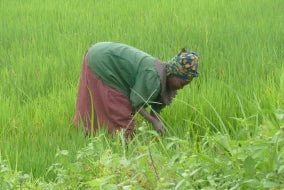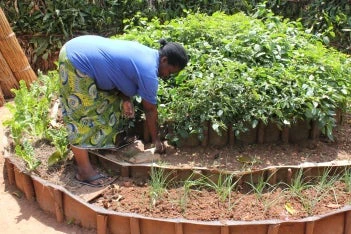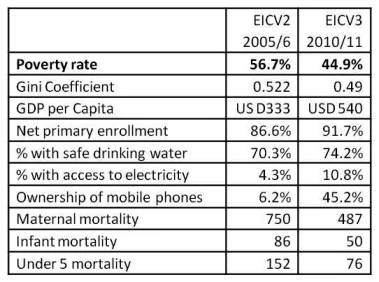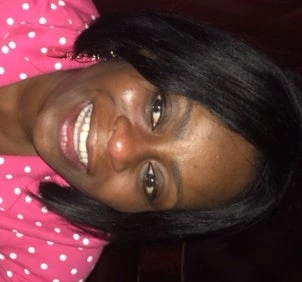
“We have built a good house, our children are nourished. When you feed well you think better….we have brought water and electricity home….” Daphrose Nyirabapagas, Musanze.
“Before Mutuelle de Sante, I used herbs for treatment when I got sick. But today, I receive proper medical treatment.” Charlotte Uwineza, Musanze.
"I collect garbage and recycle it into energy saving charcoal briquettes and sell them. Before this, I was just a simple twa, roaming around the village despised by all. But today I am a Rwanda woman like many others, well respected and earning a decent living and providing for my family. All this is thanks to the good governance, to a pro-people government…….." Daphrose Nyirabapagasi, Musanze.
So what were these results? Here are some highlights:
The first very striking point was the negligible change in poverty rates between EICV1 in 2000/2001 and EICV2 in 2005/6 (58.9% to 56.7%) contrasted with the very significant change between EICV2 in 2005/6 and EICV3 in 2010/11 (56.7% to 44.9%). What happened starting 2005/6 to bring about this step change? And what had made it possible for a land-locked country, lacking in natural endowments and situated in a challenging neighborhood to make this kind of progress?
On the first question, based on what I had seen in the countryside, I concluded that it was “something to do with agriculture”. On the second, the answer seems to be a combination of: the commitment, discipline and goal congruence of Rwanda’s leadership; the commitment of that leadership to a broad-based consultative and inclusive approach to Rwanda’s economic development; rules of the game that enshrine accountability to Rwandan citizens for delivery against that vision; the determination of the Rwandan authorities to drag its development partners kicking and screaming towards complying with that loftiest of the Paris Declaration goals – alignment with a country’s own development goals; and finally the incorporation of traditional institutions and programs into modern development theory and practice.
As the presentation unfolded, we learned that the key reasons for the reduction in the poverty rate in Rwanda were: improved agriculture production; increased agro business activity; increased farm wage employment; increases in the preponderance of non-farm wages; increases in income transfers; slowing population growth; and improvements in physical infrastructure. So my “something to do with agriculture” instinct was supported by findings for EICV3. It was also interesting to learn that a twitter campaign, conducted by the Government in the run up to publication of the results, named two agriculture-related programs – the crop intensification program and the terracing program - as among the top four programs that respondents believed to have led to poverty reduction in Rwanda over the last five years.
The fact that agriculture has been a key contributor to poverty reduction in Rwanda is of course not an accident. Rwanda’s Vision 2020, articulated in 2000 set out to transform Rwanda into a middle-income country. In 2000 Rwanda was a subsistence level, agrarian based economy (accounting for the livelihoods of more than 90% of the labor force) with around 60% of the population living below the poverty line. The distribution of arable land stood at one hectare for every 9 Rwandans and was diminishing due to high birth rates; available pastureland was estimated to be 350,000 hectares, most of which was of poor quality; there was intense exploitation of the land but no concurrent rehabilitation measures, including the use of fertilizers, being practiced. There was therefore a serious decline in land productivity, accompanied by increased environmental degradation. One of the six pillars of Vision 2020 was thus to transform “….agriculture into a productive, high value, market oriented sector, with forward linkages to other sectors...” The story of how Rwanda set about making this vision a reality is one part Development 101 and another part the uniquely Rwandan approach of blending traditional institutions and programs into modern development theory and practice.
The Development 101 part is straightforward. The articulation of a medium term economic development and poverty reduction strategy that included a focus on improving agricultural productivity; then the articulation of a strategic plan for the transformation of agriculture; and finally the alignment of expenditure envelopes with this strategic plan so that today Rwanda is one of the few African countries that meets the CAADP recommended target of 10 percent of agriculture expenditure in the national budget. Some of the specific programs and projects that have been implemented include: crop intensification techniques; widespread introduction of irrigation infrastructure in the marshlands; terracing and erosion control on the hillsides; a campaign accompanied by subsidies to increase the use of fertilizers; the introduction in 2005 of a land law that secures tenure rights for all existing private landholders; conversion of some 2,500 grass root farmer organizations into more formal cooperatives; enhanced extension services etc. etc.
But, it is the Rwandan approach of blending traditional institutions and programs into modern development theory and practice that is making the real difference.
There is for example the Girinka program. The word Girinka derives from a traditional Kinyarwanda greeting that translates to “may you own a cow”, a cow being a symbol of wealth and prosperity both in times past and present. The Girinka program is a Rwanda style social safety net program that was introduced in 2006. Instead of the more conventional conditional cash transfer system found across the world and based on a recurring transfer, Girinka makes a onetime transfer but, of a productive asset. Essentially every poor household will in due course receive a dairy cow which in turn is expected to result in better livelihood and nutrition outcomes - milk for consumption and sales, improved agricultural productivity from improved soil fertility as a result of the application of cow manure to cultivated land. To date just under 120,000 cows have been distributed and one of the mechanisms for making this program self-sustaining is the tradition that when the cow calves, the calf is given to a neighbor who in turn gives the next calf to the next neighbor and so on.
Another example is Imihigo, essentially a performance contract under which local governments articulate their objectives strategies to achieve these objectives, as well as targets and results against which performance will be judged. In Rwanda the Imihigo is entered into at a personal level between (typically) the Mayors and President Kagame, the contracts are signed publicly and performance is judged annually, again in public typically by the Prime Minister. Accountability for delivery is strictly upheld with non-performers being promptly replaced. Imihigo was also introduced in 2006. No full scale evaluation of its impact has yet been made and, as with the Girinka program, Imihigo has its fans and its detractors, but there is widespread anecdotal evidence of the spirit of competition it has engendered amongst Mayors, while a number of small scale studies would appear to point to Imihigo having a discernible impact particularly in the health sector.

Finally we have, what I consider to be, the mother of all of Rwanda’s traditional institutions, the annual Umushyikirano or national dialogue. A recent and eloquent expression of what this is comes from an article written after the December 2011 Umushyikirano by Rwanda’s Minister of Health entitled “Direct Democracy and the Health Sector: Umushyikirano 2011”. In the article Minister Binagwaho describes Umushyikirano as one of Rwanda’s “most empowering innovations”. She goes on to explain that it is “enshrined in the Constitution, guaranteeing that the people of Rwanda retain their right to participate in all decisions that guide their life….for expressing their proposals for improved policies as well as their judgments on the work of their elected leaders.” The atmosphere at the two day Umushyikirano is impossible to convey on paper. The whole of the executive leadership - Ministers, Ambassadors who get recalled for the event, Provincial Governors, Heads of Agencies etc. - are required to be present. Invited representatives from Rwanda’s awesome diaspora also participate. President Kagame plays the role of The Grand Inquisitor. The atmosphere is part inquisition, part carnival, but all business. The citizenry call, SMS, email and tweet their inputs live and uncensored, the proceedings are carried live for the two days on radio and TV and, since last year are also web streamed. Decisions are taken, programs get re-oriented, restitution where appropriate is directed.
These four traditional mechanisms, plus others that exist but which I have not described, have played a major role in the results that have been achieved - two were introduced in 2006 near to the time of the indifferent EICV2 results. So, over the next few weeks and months, as economists and statisticians pore over the data, undertake their complex regressions and correlations and ask themselves questions about the direction of causality, it would be great if someone could come up with a model that incorporates the role of traditional institutions!
A sober reminder of the unfinished agenda however comes from a recent article in The New Times, which quotes Ms Clementine Muhawenimana the owner of a market stall in Kigali’s largest market: “……things are more expensive than three of four years ago…its [i.e. poverty’s] decline is noticeable but life is still expensive and difficult….though people can still afford a meal, it’s digging into their pockets.” Rwanda’s leadership acknowledges that despite these impressive gains, huge challenges remain – the poverty rate may have declined but 44.9% of Rwanda’s population still lives on less than 900 Rwandan Francs per day - sufficient only to buy 3 liters of unpasteurized milk. What it will take to energize the SME sector, so important for the creation of jobs, remains a puzzle. Winning the war on child stunting and malnutrition is critical. And finding a fiscally responsible solution to how Rwanda will finance its massive infrastructure needs, essential to mitigating impacts of its land-locked position, is of paramount importance.
But yes, Africa can reduce poverty as the Rwanda experience very clearly illustrates.
Watch the Video Documentary: Rwanda Vision 2020 Transforming Lives



Join the Conversation